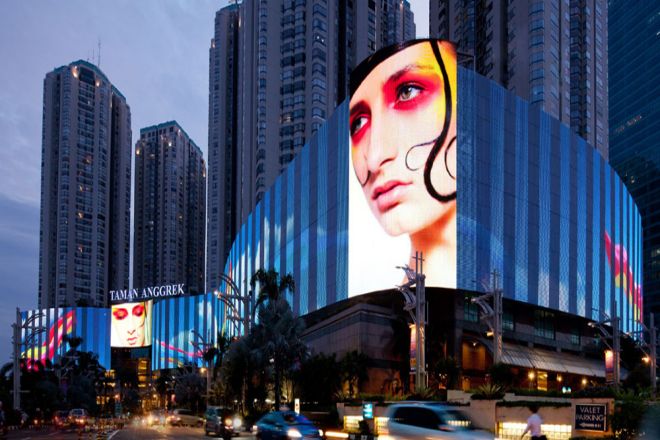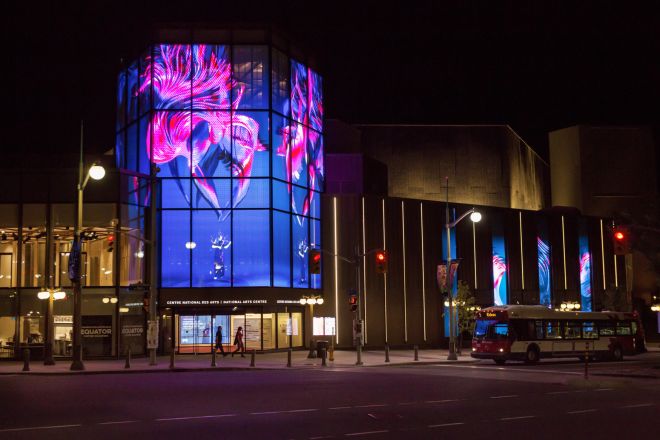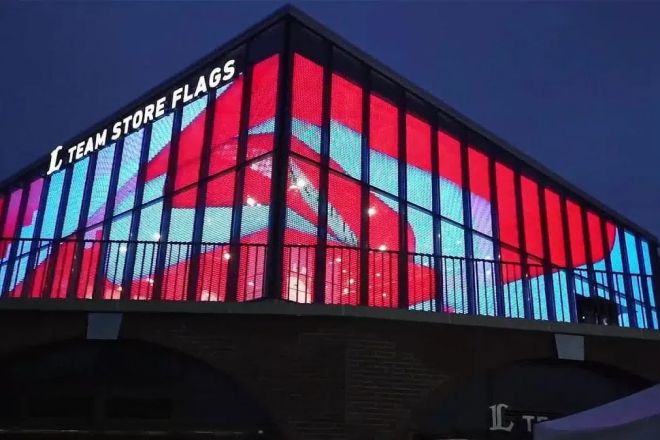Introduction

In contemporary society, where technology and art are intertwined, LED display screens are gradually becoming the most dazzling landscape under the city skyline with their unique charm.
From the dazzling light show of skyscrapers to the profound display of cultural buildings, Affichage LED screens are not only a tool for information dissemination but also a catalyst for architectural design innovation.
With unlimited creativity and flexible expression, they give new life and soul to buildings, allowing each building to tell its own story in the night and become an indispensable cultural symbol in the city.
1. The relationship between LED display screens and buildings
The relationship between LED display screens and buildings is becoming increasingly close. The interaction between them not only changes the appearance of buildings but also enriches the functions and cultural connotations of buildings. The following is a detailed explanation of the relationship between LED display screens and buildings:
1). LED display screens give buildings a new appearance
Attrait visuel:
LED display screens, with their high brightness, high resolution, and wide viewing angle, provide buildings with a new and bright appearance at night. Through flexible lighting and dynamic image display, buildings can become vivid and eye-catching at night, greatly improving the visibility and recognition of buildings.
Creative expression:
LED display screens provide architects and designers with a huge creative space. They can use the flexibility of LED display screens to update the appearance of buildings in real-time according to different festivals, events, or special occasions to convey specific information or emotions. This dynamic change not only increases the interest of the building but also makes the building a unique landscape in the city.
2). LED display screen expands the function of buildings
- Diffusion de l'information:
LED display screens are not only decorative elements but also can be used for information dissemination. The exterior wall of the building has become a colorful media that can be used to publish real-time traffic information, weather conditions, etc., to improve the convenience of citizens’ lives.
At the same time, it can also serve as an advertising platform to promote products and services and provide strong support for commercial activities.
- Art display:
LED display screens can also be used for art display. By playing dynamic visual works or works of art at specific times, LED display screens transform buildings into huge display platforms, adding artistic atmosphere and cultural heritage to the city.
2. How LED display screens are integrated with creative buildings

- The dynamic coat of landmark buildings
LED display screens are cleverly integrated into landmark buildings and become their dynamic coats. These displays not only show the unique style of the building but also attract public attention through constantly changing light and shadow effects.
For example, the naked-eye 3D screen in Chengdu Taikoo Li uses advanced naked-eye 3D technology to make images appear on the screen, creating stunning visual effects, such as “spaceships” flying through the sky and “pandas lifting the curtain” to show local characteristics, which not only attracted a large number of tourists and citizens to stop and watch but also greatly enhanced the city’s popularity and reputation.
- Interactive display of cultural buildings
In cultural buildings, LED screens are used as a platform for interactive display, telling historical stories and displaying artworks through dynamic images, videos, and sounds, enhancing the audience’s sense of participation and immersion.
This display method breaks the boundaries of traditional static exhibitions, making cultural content more vivid and interesting, and easier to be accepted and loved by the public.
- Light and shadow feast in commercial complexes
Commercial complexes use LED screens to create a light and shadow feast, adding infinite fun to shopping, entertainment, and leisure activities. For example, the LED skylight of Zhuhai Huafa Commercial City, the world’s largest creative LED skylight, has attracted countless people’s attention with its huge size and unique design.
When night falls, the skylight lights up, turning the building into a dazzling world of light and shadow, providing shoppers with a visual feast and promoting the prosperity of commercial activities.
- Environmental Declaration of Green Buildings
In green buildings, LED display screens are not only used to show the beauty of the building but also bear the responsibility of environmental protection publicity. These display screens convey environmental protection concepts to the public and advocate low-carbon life by displaying themes such as energy conservation emission reduction and green ecology.
At the same time, green buildings themselves also focus on energy conservation and emission reduction, and LED display screens are used as lighting and display means, which further reflect the environmental protection characteristics of the building.
- Art installations in public spaces
In public spaces such as city squares and parks, LED display screens are designed as various art installations and become part of urban culture. These installations create amazing visual effects through unique shapes and light and shadow effects, providing citizens and tourists with a rich visual experience.
At the same time, they also undertake functions such as information transmission and cultural exchange, which promote the prosperity and development of urban culture. For example, some public art installations use LED display screens to display urban history, cultural characteristics, and other content, enhancing citizens’ sense of identity and pride in urban culture.
3. Design principles, challenges, and solutions for LED display screens in creative buildings
1). Design principles
- Coordination with architectural style:
The design of LED display screens should be coordinated with the architectural style. Whether it is modern simplicity, classical elegance, or future technology style, the appearance, color, and light and shadow effects of the display screen should be consistent with the overall building to avoid abruptness.
Through carefully designed shapes and color matching, the display screen becomes a part of the building rather than a simple addition.
- The creativity of light and shadow effects:
LED display screens should make full use of their dynamic characteristics to create unique and creative light and shadow effects. Through programming control, various forms of display, such as images, texts, and animations, can be realized to enhance the visual impact and enhance the audience’s viewing experience.
At the same time, the light and shadow effects should match the function and atmosphere of the building to create a comfortable and harmonious environment.
- Accuracy of information communication:
When LED display screens are used for information dissemination, the accuracy and timeliness of the information must be ensured. Avoid misleading content to ensure that the audience can clearly and accurately obtain the required information.
At the same time, we should also pay attention to creativity and attractiveness in the way of information display to improve the effect of information dissemination.
2). Technical Challenges
- Installation Difficulty:
The installation of large LED display screens often involves difficulties such as high-altitude operations and complex structure construction, which requires extremely high installation technology and safety.
In addition, it is also necessary to consider the close integration of the display screen and the building structure to ensure that it can operate stably under various weather conditions.
- Problème de dissipation de chaleur :
LED display screens will generate a lot of heat during operation. If the heat dissipation is poor, it will cause temperature rise, performance degradation and even damage. Therefore, effective heat dissipation measures need to be taken, such as designing a reasonable heat dissipation structure and using efficient heat dissipation materials.
- Waterproof and dustproof requirements:
Affichage LED extérieur screens need to have good waterproof and dustproof performance to cope with severe weather conditions. This requires the display screen to use special materials and processes during the design and manufacturing process to ensure that it can still work normally in a humid and dusty environment.
- Energy consumption management:
Although LED display screens have lower energy consumption than traditional lighting equipment, energy consumption issues still need to be paid attention to when used on a large scale. By optimizing circuit design, adopting energy-saving technology, and intelligent management, the energy consumption of the display screen can be reduced and energy utilization efficiency can be improved.
3). Solutions
- Innovation technique :
Installation difficulties and heat dissipation problems, can be solved through technological innovation. For example, develop more advanced installation technology and equipment to improve installation efficiency and safety; develop more efficient heat dissipation materials and structures to reduce the operating temperature of the display.
- Material optimization:
Select high-performance and high-reliability materials to manufacture LED display screens, such as using weather-resistant shell materials and high-transmittance lenses to improve the waterproof and dustproof performance and display effect of the display screen.
- Gestion intelligente :
Remotely monitor and control the LED display screen through an intelligent management system to achieve refined management of energy consumption. For example, automatically adjust the brightness and playback content of the display screen according to the ambient light and traffic conditions to reduce energy consumption.
Tmely discover and handle faults through an intelligent early warning system to improve the reliability and stability of the display screen.
- Multi-party cooperation:
When designing and implementing LED display screen projects, architects, engineers, designers, and other parties need to cooperate to jointly formulate reasonable design and technical solutions.
Through interdisciplinary cooperation and exchanges, each party can give full play to its professional advantages and jointly solve technical problems and challenges.
4. Perspectives d'avenir

1). Predict the development trend of LED display screen technology in architectural design.
- Résolution plus élevée :
With the continuous advancement of technology, LED displays will achieve higher resolution and better picture quality. LED displays with ultra-high definition (UHD), 4K, and even 8K resolution will become mainstream, bringing more delicate and realistic display effects to architectural design.
This will enable the exterior walls, interior decoration, and other spaces of buildings to present more complex and detailed images and video content, enhancing the visual impact.
- More intelligent:
In the future, LED displays will be more intelligent, integrating technologies such as sensors, artificial intelligence, and cloud computing to achieve functions such as intelligent control, remote monitoring, and data sharing.
For example, LED displays can automatically adjust parameters such as brightness and color temperature according to factors such as ambient light and traffic flow to achieve the best visual effect and energy consumption balance.
At the same time, intelligent LED displays can also be linked with other building intelligent systems (such as security, lighting, etc.) to improve the overall management level of the building and the quality of life of residents.
- More environmentally friendly:
Environmental protection and sustainable development are important development directions for LED display technology in the future. In the future, LED displays will adopt more environmentally friendly materials, lower energy consumption designs, and more effective waste treatment methods to reduce negative impacts on the environment.
For example, by optimizing the luminous efficiency and heat dissipation performance of LED chips, energy consumption, and heat emissions can be reduced; by using recyclable or biodegradable materials to make display housings brackets and other components, waste generation can be reduced.
2). Analyze how LED display screens can further promote the harmonious coexistence of buildings and urban environment and improve the quality of life of residents.
- Beautify urban landscape:
High-resolution and intelligent LED display screens can add unique visual effects to buildings, making them highlights and landmarks in the city.
At the same time, by playing content related to urban culture, history, natural landscape, etc., LED display screens can enrich the cultural connotation and aesthetic experience of the city and enhance the overall image of the city.
- Enhance interactivity:
LED display screens can not only be used to display static images and video content but also interact with the audience through integrated touch screens, voice recognition, and other interactive technologies.
This interactivity can not only enhance the audience’s sense of participation and experience but also add more fun and vitality to urban public spaces.
- Improve the quality of life of residents:
The application of LED display screens in architectural design can also provide residents with a more convenient and comfortable living environment.
For example, LED display screens are set up in public areas such as communities and parks to publish practical information such as weather forecasts, traffic information, and community announcements.
LED display screens are set up in commercial places such as shopping malls and hotels to display product information, promotional activities and other content that attracts customers. These applications all help to improve the quality of life and happiness of residents.
- Emphasize the importance of cross-border cooperation.
Cross-border cooperation is an important way to promote the continuous innovation and development of LED display technology in architectural design. The joint participation of designers, engineers, artists, and other forces can break the boundaries and barriers of traditional disciplines and realize the cross-integration of knowledge and technology in different fields.
Through cross-border cooperation, more innovative and practical LED display application solutions can be created to meet the diverse needs and challenges in architectural design.
Cross-border cooperation also helps to promote the standardization and normalization of LED display technology. Formulating unified technical standards and specifications can ensure that LED displays produced by different manufacturers are consistent and interoperable in terms of performance, quality, interface, etc., thereby reducing application costs and risks.
At the same time, cross-border cooperation can also promote close cooperation and coordinated development between upstream and downstream enterprises in the industrial chain, forming a benign industrial ecology and competitive advantages.
Conclusion
Looking back on the development of LED display in architectural design, it is not difficult to find that it has evolved from a simple information dissemination medium to an important force to promote architectural innovation and enrich urban culture.
From towering skyscrapers to cultural landmarks full of artistic atmosphere, LED display screens have injected infinite imagination and possibilities into urban space with their unique light and shadow charm.
Enfin, si vous souhaitez en savoir plus sur les écrans LED, veuillez nous contacter.
